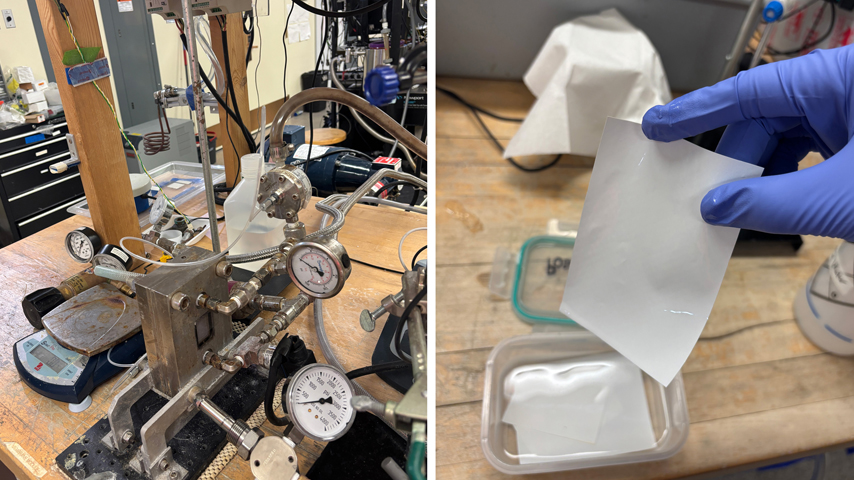Optimized Recycling in Aluminum Production
Optimized Recycling in Aluminum Production


Researchers have developed a new filter that can capture and recycle aluminum from manufacturing waste.
Smelting plants lose valuable aluminum when contaminated cryolite needs to be replaced in a process that both drives up costs and waste. Researchers at the Massachusetts Institute of Technology (MIT), working with Japanese manufacturer Nitto Denko, are tackling this issue with development of a nanofiltration process that recovers aluminum from discarded cryolite.
In the Hall-Héroult process—currently the most widely used method to smelt aluminum—refiners dissolve alumina in a molten cryolite bath, lowering the melting point for efficient electrolysis. Inside the electrolytic cells, carbon-lined cathode melted the aluminum, while carbon anodes produced carbon dioxide. Workers collect the molten aluminum and cast it into various forms.
But this process introduces impurities like sodium, lithium, and potassium ions, all of which weaken cryolite’s ability to dissolve alumina. So, when smelters remove spent cryolite, they also discard residual aluminum. But the MIT team’s filtration method instead captures these aluminum ions, reducing waste and improving resource efficiency.
“We devised a membrane that splits the feed solution into two streams; one rich in monovalent cations, such as sodium chloride 1+, which we can easily dispose of, and another containing multivalent cations like aluminum 3+, which we recycle back into production for added aluminum extraction,” explained Zi Hao Foo, a professor of mechanical engineering and computational science at MIT and second author of “Enhancing Resource Circularity in Aluminum Production through Nanofiltration of Waste Cryolite,” alongside Trent R. Lee, under the guidance of Professor John Lienhard.
More for You: Membrane Could Be Key to Carbon Sequestration
A thin, positively charged coating creates the nanofiltration membrane’s passive surface charge, enhancing the membrane’s ability to separate sodium from aluminum, enabling better aluminum recovery. The membrane blocked 99.7 percent of aluminum ions while allowing cryolite, sodium, lithium, and potassium ions to pass through.
During testing, the team used a small, playing card-sized membrane coupon to test the aluminum-cryolite separation efficiency and durability.
“We placed the membrane in a hydrochloric acid solution for up to four weeks, periodically testing sections for performance. The results showed no degradation in selectivity, suggesting strong tolerance to acidic conditions,” Foo explained.
Now, the researchers are working with a manufacturer to scale the membrane for commercial use.
Pumping power
The spiral-wound membrane configuration, commonly used in desalination plants, effectively separates aluminum from spent cryolite. A flat-sheet membrane wraps around a collection tube formed channels through which the cryolite solution spirals. The pressurized cryolite solution enters the system, allowing ions like cryolite, sodium, lithium, and potassium to pass through to a central collection tube, while blocking the aluminum solution so it can exit the module. This design offers several benefits, such as a high membrane surface area in a compact space, reduced fouling due to turbulent flow, and cost-effective manufacturing.
A high-pressure pump moves spent cryolite sludge toward the membrane. Since the membrane carries a passive charge and requires no electric input, the pump consumes most of the energy in this process. The monovalent-rich solution exits the membrane at atmospheric pressure, while the multivalent aluminum solution exits as a high-pressure stream. An energy recovery device, in the form of a pressure exchanger, captures the flow energy from this stream.
“Combining a high-pressure pump with an energy recovery device significantly reduced the energy consumption by up to 80 percent,” Foo explained.
Pressure exchangers, common in reverse osmosis systems, use internal chambers to transfer pressure between the outgoing and incoming streams. As the high-pressure solution exited the membrane, it enters these chambers, displacing the lower-pressure incoming solution and pre-pressurizing it. This process reduces the workload and energy consumption of high-pressure pumps. Unlike open-loop systems, which waste energy by discharging high-pressure reject streams, this system acts as a closed pressure loop, recycling hydraulic energy, improving membrane efficiency, reducing operational costs, and enhancing sustainability.
A vital resource
Aluminum ranked as the second most-produced metal worldwide, with manufacturers generating approximately 70 million metric tons annually. Production continued to climb, driven by demand across multiple industries. China leads as the dominant producer, followed by India, Russia, and Canada, with key contributions from the United Arab Emirates, Bahrain, Australia, and Norway.
Industries value aluminum for its versatility in automotive, aerospace, construction, packaging, and electrical engineering. Smelters operate near affordable electricity sources to support the energy-intensive production process. As energy concerns have grown, the industry has focused on higher recycling rates and more sustainable methods.
Bauxite, the primary source of alumina, is mined using destructive open-pit methods that erode soil, contaminate water, and destroy habitats. The Bayer process extracts alumina but creates highly alkaline "red mud" laden with heavy metals, requiring hazardous storage.
Discover the Benefits of ASME Membership
Cryolite, a mix of sodium, aluminum, and fluorine, plays a key role in the Hall-Héroult process by lowering aluminum's melting point to a more stable and energy-efficient temperature. The sodium-to-aluminum atom ratio in the cryolite solution must not exceed 2.5; if it does, the cryolite no longer optimizes melting, conductivity, or solubility. Once the ratio reaches this point, the cryolite is removed. Recycling cryolite supports a circular economy by treating waste and reducing reliance on newly mined bauxite, promoting a more sustainable aluminum industry.
“When cryolite becomes contaminated with sodium and potassium ions, plants discard it, making waste processing a significant part of operational costs. Creating a flow path to purify and reuse cryolite solutions can greatly reduce operating expenses and make the extraction process more economically viable,” Foo explained.
The MIT and Nitto Denko team’s nanofiltration process is advancing aluminum recovery and sustainable cryolite management. By selectively separating aluminum ions while allowing monovalent ions to pass, this process is an efficient, scalable solution for smelting waste. Integrating energy recovery devices further reduces energy consumption, making the process cost-effective and environmentally sustainable.
“Efficient production, separation, and reuse of metals has become a critical issue in recent years,” Lienhard said. “Research and development activities have risen sharply, and I expect this interest will continue to grow.”
Nicole Imeson is an engineer and writer in Calgary, Alberta.




